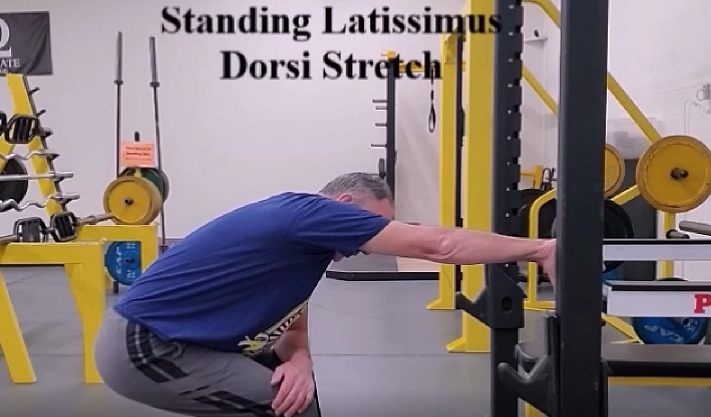Stretch the big powerful latissimus dorsi muscles to reduce muscle tension, improve posture and increase back and shoulder motion. Tightness in the latissimus dorsi can lead to limited function, improper motion and poor posture. Use proper latissimus dorsi muscle stretching techniques to improve function, enhance motion and correct postural flaws such as Upper Cross Syndrome.
Latissimus Dorsi (Lats)
Origin: Spinous processes of T7 to T12, iliac crest, thoracolumbar fascia, inferior 3rd & 4th rib and inferior angle of scapula.
Insertion: Intertubercular groove of humerus.
Concentric Actions: Adduction, internal rotation & extension of humerus.
Innervation: Thoracodorsal nerve (C5, C6, C7, C8).
Shoulder Internal Rotators: Latissimus Dorsi, Teres Major & Subscapularis.
Primary muscle used in rope climbing is the latissimus dorsi.
Standing Latissimus Dorsi Stretch
Stand in front of a sturdy pole or structure.
Feet facing forward. Knees bent slightly.
Internally rotate shoulder (Thumb facing floor).
Grab pole slightly higher than waist height.
Hinge at hips and bend knees further.
Stretch body posterior until a mild comfortable stretch is felt in the latissimus dorsi muscle.
Rotate trunk to ipsilateral side to increase stretch.
Hold a mild comfortable stretch in latissimus dorsi for 10 to 120 seconds.
Move out of the stretch slowly.
Repeat on opposite side.
Supine Foam Roller Latissimus Dorsi Stretch
Supine on foam roller.
Head and sacrum supported on roller.
Keep both feet contacting floor and lower thoracic spine contacting roller.
Flex shoulders 180°.
Let scapulae drop downward and wrap around roller.
Stretch shoulders posterior and superior.
With non-stretching hand grasp wrist of working arm.
Gently pull shoulder superior and overhead.
Hold a mild comfortable stretch in latissimus dorsi for 10 to 120 seconds.
Move out of the stretch slowly.
Repeat on opposite side.
Hanging Latissimus Dorsi Stretch: Single Arm
Using one hand, grip pull-up bar over head or over opposite shoulder with pronated or neutral grip.
Place toes on a bench, floor or ground.
Shift legs and feet toward opposite side.
Shift pelvis to ipsilateral side.
Hold mild comfortable stretch in latissimus dorsi for 10 to 120 seconds.
Move out of the stretch slowly.
Repeat on opposite side.
Use these stretches to lessen tension in the latissimus dorsi muscles. Follow proper stretching techniques to improve posture, shoulder function and spine health. Move into the stretch slowly, hold a mild comfortable stretch and move out of the stretch slowly. If an exercise or stretch elicits or intensifies symptoms, please stop immediately and find a viable substitute.
Disclaimer: Viewing this video does not take the place of seeing a medical professional, receiving proper training in the medical profession or working with a fitness professional. Please visit a medical professional for evaluation, diagnosis and treatment. Please work with a fitness professional to learn proper exercise technique and to develop a proper training program. Never perform an exercise that elicits or intensifies symptoms. If an exercise elicits or intensifies symptoms, stop immediately and use a viable substitute. Please receive proper medical training before attempting these medical procedures.
Dr Donald A Ozello DC of Championship Chiropractic in Las Vegas, NV
Web Site: http://www.championshipchiropractic.com/
Blog: https://www.championshipchiropractic.com/wordpress/
Twitter: https://twitter.com/drdozellodc
Facebook: https://www.facebook.com/Championship-Chiropractic-280141628688300/
LinkedIn: https://www.linkedin.com/in/dr-donald-a-ozello-dc-716b3233
YouTube: https://www.youtube.com/user/drdozellodc/videos
“Running: Maximize Performance & Minimize Injuries” https://www.amazon.com/Running-Performance-Chiropractors-Minimizing-Potential/dp/1493618741

